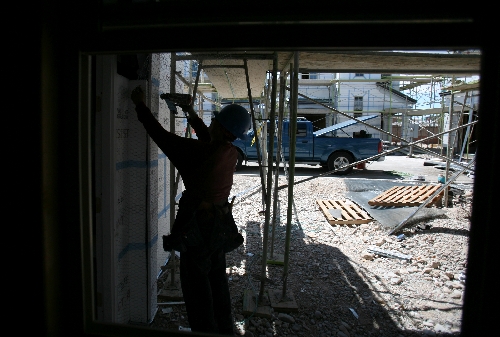U.S. housing starts decline in November
WASHINGTON - U.S. builders broke ground on fewer homes in November after starting work in October at the fastest pace in four years. Superstorm Sandy likely slowed starts in the Northeast.
The Commerce Department said Wednesday that builders began construction of houses and apartments at a seasonally adjusted annual rate of 861,000. That was 3 percent less than October's annual rate of 888,000, the fastest since July 2008.
Still, the decline follows months of strong gains. Housing starts remain on track for their best year in four years, and the housing market overall appears to be sustaining its recovery.
An encouraging trend was that applications for building permits, a sign of future construction, rose to 899,000 in November, the most since July 2008.
"Growth in housing starts was extremely strong in the prior three months ... so some giveback is not a concern at this point," said Robert Kavcic, an economist at BMO Capital Markets.
Housing starts fell 5.2 percent in the Northeast from October to November. Starts in the West fell 19.2 percent. Over the past year, housing starts have declined nearly 26 percent in the Northeast, the only region to record a year-over-year drop. That suggests that Sandy slowed construction in the region.
Thousands of homes destroyed by the storm will likely be rebuilt in coming months, economists say. But the increase in construction starts won't likely be noticeable on a national scale or in any single month.
Patrick Newport, a housing economist at IHS Global Insight, estimates that about 40,000 destroyed homes will be rebuilt over the next three years. The rebuilding will boost housing starts by 16,000 next year, 16,000 in 2014 and about 8,000 in 2015, Newport estimates. Next year, housing starts could reach 900,000, so the rebuilding from Sandy will scarcely move the national data.
The overall slide in construction in November was due mostly to single-family homes. Builders began work on 4.1 percent fewer single-family homes than in October. Construction of apartment buildings, which tends to fluctuate sharply, dipped 1 percent in November.
Housing starts were 21.6 percent higher last month than in November 2011. Housing starts are far above the annual rate of 478,000 touched in April 2009, the recession low. They're still well short of the roughly 1.5 million annual rate consistent with a healthy market.
But numerous signs suggest that the housing market is picking up. Builder confidence rose in December for a seventh straight month to the highest level in more than 6½ years, according to a survey released Tuesday by the National Association of Home Builders/Wells Fargo.
The index of builder sentiment rose two points to 47, the highest since 2006. Builders are more optimistic, in particular, about current sales and buyer traffic, the survey found.
More people are looking for a new house or apartment, encouraged by modest job gains, a gradually improving economy and mortgage rates near record-low levels. At the same time, fewer homes are available for sale. The low supply is helping lift prices.
Sales of previously occupied homes rose 2.1 percent in October.






















